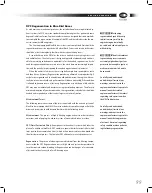
107
r o u t i n e
o p e r a t i o n
General Propane Tank Filling Procedures
The most important procedure of filling any propane tank is safety. Understanding
the properties & characteristics and safe handling practices of the fuel is required
before conducting any propane tank filling efforts.
A propane powered vehicle is equipped with a propane tank built to and cer-
tified to the regulations of the American Society of Mechanical Engineers (ASME)
These tanks have a data plate with pertinent information including the ASME stamp
and the plate must be securely attached and legible or the tank should be taken
out of service and replaced. There are no requirements for re-certifying ASME tanks
however inspection is required and maintenance is recommended if there are signs
of corrosion.
Propane tanks are filled to 80% capacity to allow for the liquid fuel to expand and
contract depending on ambient or other influent temperatures. All tanks built for
use on motor vehicles are equipped with overfilling prevention protection. The Na-
tional Fire Protection Association (NFPA) have required motor vehicle propane tanks
be equipped with a stop filling device to automatically prevent overfilling or filling
the tank beyond the maximum recommended capacity of 80%. This automatic stop
fill system provides the primary method of preventing overfill of the fuel tanks. This
rule has been in effect since January 1, 1984.
As a secondary means of preventing an overfill condition of the fuel tanks and
a means of verifying the accuracy of the automatic stop fill device, the tanks are
equipped with an 80% fixed maximum liquid level outage valve (Manual bleeder
valve). The valve would be used to verify when the liquid fuel reaches the 80% level
at which point the fill process would be stopped. This valve can be used when filling
and releases fuel in a vapor phase until the fuel reaches the 80% level at which time a
stream of liquid will appear indicating the fuel level in the tank is 80%. Most propane
fueling stations will want to open this bleeder valve however since the propane mo-
tor vehicle tank is equipped with an overfill prevention device it is not necessarily
required and may be prohibited in certain municipalities where the release of hy-
drocarbons to the atmosphere is prohibited. The NFPA ruled that when the tank is
equipped with an overfill prevention device the use of the 80% bleeder valve is not
required.
[WARNING]
Technicians work-
ing with, or around, fuel systems
should be properly trained to
utilize extreme care and caution
at all times. Failure to exercise
extreme caution and care may
lead to serious accidents which
can result in property damage,
personal injury and/or death.
Содержание VISION 2011
Страница 1: ...10013333 2011 BBCV D R I V E R S H A N D B O O K 10013333 BBCV BLUE BIRD VISION 2011 ...
Страница 2: ......
Страница 3: ...10013333 Revision B ...
Страница 8: ...VISION D R I V E R S H A N D B O O K 6 ...
Страница 26: ...VISION D R I V E R S H A N D B O O K 24 ...
Страница 70: ...VISION D R I V E R S H A N D B O O K 68 ...
Страница 137: ...135 Notes n o t e s ...
Страница 138: ...VISION D R I V E R S H A N D B O O K 136 Notes ...
Страница 139: ......
Страница 140: ...10013333 2011 BBCV D R I V E R S H A N D B O O K 10013333 BBCV BLUE BIRD VISION 2011 ...































